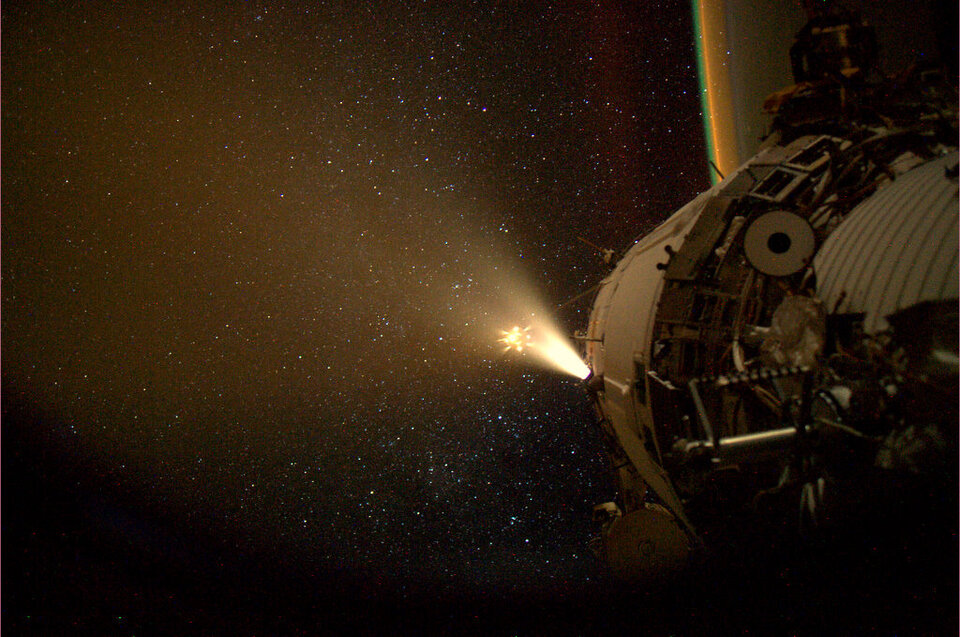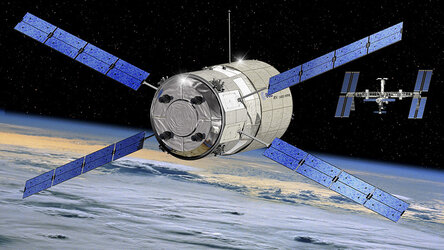ATV-3: Edoardo Amaldi
The third ATV was launched to the International Space Station on 23 March 2012 at 04:34 GMT from Europe's Spaceport in Kourou, French Guiana. ATV-3 was named after famous Italian physicist and spaceflight pioneer Edoardo Amaldi.
The Italian space agency, ASI, proposed naming ATV-3 after the Italian physicist Edoardo Amaldi (5 September 1908 – 5 December 1989).
"He started working in nuclear physics with Enrico Fermi, did pioneering work in the field of cosmic rays and in the new field of particle physics, becoming an Italian reference character in nuclear science," said Enrico Saggese, President of ASI.
"Amaldi was one of the few who in the post-war years prompted action ultimately leading to the founding of ESRO, and later ESA."
Father of Italian space research

Edoardo Amaldi was a leading figure in Italian science in the 20th century, particularly in fundamental experimental physics.
In Rome, in the 1930s, Amaldi was a member of a group of young Italian scientists: the Via Panisperna boys ('I ragazzi di Via Panisperna'), who, led by Enrico Fermi, made the famous discovery of slow neutrons, which later made possible the nuclear reactor.
He contributed to nuclear physics in the 1930s and 1940s and to cosmic rays and particle physics afterwards.
At the beginning of the 1950s, Amaldi was one of the founding fathers of the European Organisation for Nuclear Research (CERN) and from 1952 to 1954 he was Secretary General of CERN's provisional organisation.
He then became a pioneer in the experimental search for gravitational waves in the 1970s.
It is largely thanks to his drive that Italian physics emerged from the slump following the Second World War.
Amaldi's concern for peace, and his strong feeling for the responsible role that the scientific community should play in this respect, was always a natural complement to his unshakable belief in the open nature of science and the need for international cooperation.

"Italy is a key European country in our participation to the International Space Station partnership. By naming the ATV-3 after Edoardo Amaldi we celebrate a great Italian, but also a committed European who understood the importance of pooling resources and minds together to achieve important results," said Simonetta Di Pippo, ESA Director for Human Spaceflight.
"We are paying tribute to a visionary mind, to a great scientist but also to an idea of cooperation that is also embodied in the International Space Station partnership."
"The ATV is the first recurring production of an exploration spacecraft and places Europe a step closer to our partners. I am glad that Italy is taking so much pride in their participation in the ISS which is a recognition of their human and industrial capabilities."
ATV-3 mission
During its mission, Edoardo Amaldi delivered nearly seven tonnes of propellant, oxygen, air and water, as well as scientific equipment, spare parts, supplies, clothes and food to the astronauts circling Earth.
The dry cargo consisted of more than a hundred of bags packed into eight racks – two more racks than on previous ATV missions.
ATV-3 was lofted to orbit on 23 March by an Ariane 5 launcher and docked with the Space Station five days later.
ATVs perform all manoeuvres, including docking autonomously, under close surveillance by their control centre in Toulouse, France run jointly by ESA and CNES.

So far, ATVs and Russian vehicles Progress and Soyuz are the only vehicles able to dock with the Station fully autonomously, with built-in redundancy.
While docked, ATV-3 performed nine reboosts to keep the Space Station in orbit, counteracting the effects of atmospheric drag.
On 22 August, ATV-3’s eighth boost lasted for 40 minutes (nearly half an orbit) and raised the Station to new heights – a record-breaking 405 x 427 km above Earth.
During the six months that ATV-3 spent at the Station, it provided 48 cubic metres of extra space for the astronauts. Before its departure, the crew loaded its pressurised module with waste material.
The European ferry undocked on September 28 and after a short free flight, it manoeuvred into a safe reentry trajectory. Edoardo Amaldi and its waste burnt up harmlessly in the upper atmosphere at 01:30 GMT.







